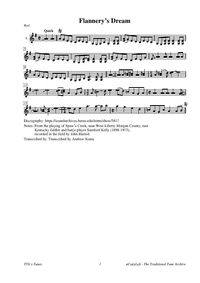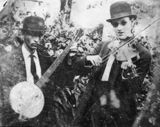Template:Pagina principale/Vetrina: Difference between revisions
No edit summary |
No edit summary |
||
| Line 1: | Line 1: | ||
{{SheetMusic | {{SheetMusic | ||
|f_track= | |f_track=Flannerys Dream.mp3 | ||
|f_pdf= | |f_pdf=Flannerys Dream.pdf | ||
|f_artwork= | |f_artwork=Ed Haley.jpg | ||
|f_tune_name= | |f_tune_name=Flannery's Dream | ||
|f_track_title= | |f_track_title=Flannery's_Dream | ||
|f_section= | |f_section=abc | ||
|f_played_by=[https://soundcloud.com/ | |f_played_by=[https://soundcloud.com/gerrymilnes Gerry Milnes] | ||
|f_notes= | |f_notes= James Edward “Ed” Haley (1885-1951). | ||
|f_caption= | |f_caption=There are several variants of "Flannery's Dream, variously more or less distanced from one another, played sometimes under the title "Flander's Dream" (although there are also different tunes by that name, one in the key of 'C') or as "Flandery's Dream." It was in the repertoire of regionally influential fiddler Ed Haley (1885-1951) according to northeast Kentucky fiddler J.P. Fraley[1] (1923-2011). | ||
|f_source=[https://soundcloud.com/ | |f_source=[https://soundcloud.com/gerrymilnes/flannerys-dream Soundcloud] | ||
|f_pix=420 | |f_pix=420 | ||
|f_picpix=200 | |f_picpix=200 | ||
|f_article=[[ | |f_article=[[Flannery's_Dream | '''Flannery's Dream''']] | ||
Warner Walton tells the (rather apocryphal) story that Flannery was a Revolutionary War fiddler who was under a sentence of death. The commanding officer, knowing he could play, agreed to set him free if Flannery could play him a tune he hadn't heard. Flannery dreamt this tune the night before his scheduled execution. | |||
John Hartford pointed out that Flannery may have been a Civil War figure rather than a Revolutionary War soldier, and, in any case, the story is quite similar to one told about West Virginia's Solly Carpenter (see note for "[[annotation:Camp Chase (2)]]"). | |||
Hartford notes the Flannery family is a large and old one from Elliott County, Kentucky. Another common story attached to the tune (and told by Alva Greene, for one) is that a man named Flannery dreamed this tune and won a contest with it (Hartford, 1996). Folklorist Steve Green related another apocryphal story he had from collector Bruce Greene about a contest between Kentucky fiddlers J.W. Day and Jim Flannery to see who would run out of tunes first. | |||
Evening wore into night without a clear winner, and, too exhausted to play any more the pair went to sleep. While dozing, Flannery had a dream about being chased by a bear playing a tune. | |||
Flannery, upon waking, recalled the tune and called it "'''Flannery's Dream'''," promptly played it and was declared the victor in the competition. | |||
}} | }} | ||
Revision as of 09:23, 6 October 2023

Played by: Gerry Milnes
Source: Soundcloud
Image: James Edward “Ed” Haley (1885-1951).

Warner Walton tells the (rather apocryphal) story that Flannery was a Revolutionary War fiddler who was under a sentence of death. The commanding officer, knowing he could play, agreed to set him free if Flannery could play him a tune he hadn't heard. Flannery dreamt this tune the night before his scheduled execution.
John Hartford pointed out that Flannery may have been a Civil War figure rather than a Revolutionary War soldier, and, in any case, the story is quite similar to one told about West Virginia's Solly Carpenter (see note for "annotation:Camp Chase (2)").
Hartford notes the Flannery family is a large and old one from Elliott County, Kentucky. Another common story attached to the tune (and told by Alva Greene, for one) is that a man named Flannery dreamed this tune and won a contest with it (Hartford, 1996). Folklorist Steve Green related another apocryphal story he had from collector Bruce Greene about a contest between Kentucky fiddlers J.W. Day and Jim Flannery to see who would run out of tunes first.
Evening wore into night without a clear winner, and, too exhausted to play any more the pair went to sleep. While dozing, Flannery had a dream about being chased by a bear playing a tune.
Flannery, upon waking, recalled the tune and called it "Flannery's Dream," promptly played it and was declared the victor in the competition.
...more at: Flannery's Dream - full Score(s) and Annotations
X:1 T:Flannery's Dream N:From the playing of Spaw's Creek, near West Liberty Morgan County, east N:Kentucky, fiddler and banjo player Santford Kelly (1898-1973), N:recorded in the field by John Harrod. M:C| L:1/8 Q:"Quick" R:Reel D:https://soundarchives.berea.edu/items/show/3817 Z:Transcribed by Andrew Kuntz K:Ador V:1 clef=treble name="1." [V:1] +slide+[A2A2][A2A2]||SAGED CEDC|A,G,A,C A,2[A,E][A,E]|([EA]G)E-D CEDC|A,G,[A,E][A,E] [A,2E2][A,E][A,E]| ([EA]G)E-D CEDC|A,G,[A,E]-[CE] [A,2E2][A,E][A,E]|([EA]G)E-D CEDG|E+slide+[A2A2][AA] [A2A2][AA]A| AGED CEDC|A,G,A,C [A,3E3][A,E] [A,2E2]||[A2A2]-|[AA]A[A=c]-[A^c][A2A2][A2^c2]|[M:5/4]A([A2^c2]d) [d2e2]-[e4e4]| +slide+[e4e4] +slide+[e4e4] ([de][^ce]) A2 GB|[M:3/2]A-^c2-d[e2e2]([ee]d) =c-AG-A|[M:C|] [A2A2][AA][AA] [A2A2][GA]-| [A3A3][A=c]-[A2d2]+slide+[e2e2]-|[M:5/4][ee]d e2 a3a- ab |[M:C|]a2g2e2d2|=cAGc A2 ABS||
